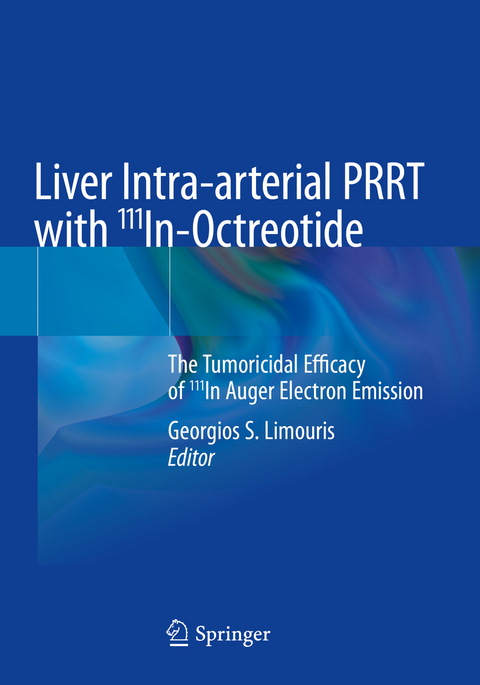
Liver Intra-arterial PRRT with 111In-Octreotide
Springer International Publishing (Verlag)
978-3-030-70775-0 (ISBN)
This book describes in detail a clinical project that reveals the tumoricidal efficacy of Auger and internal conversion electrons, emitted from n.c.a. 111In and implemented in oncology as a treating armamentarium for peptide receptor radionuclide therapy (PRRT), targeting small size (ø 20 mm) tumors and micro-metastases.
The keen interest in n.c.a. 111In began when it was observed that its Auger electron emission could be highly radiotoxic, due to its high LET when it decayed in the vicinity of cellular DNA. The somatostatin analog octreotide, labeled with [111In-diethylenetriaminepentaacetic acid (DTPA0-D-Phe1)] is an established diagnostic agent for the imaging of somatostatin receptor-positive neuro- (or non-neuro) endocrine tumors. It relies on receptor-mediated binding, internalization and installation in the lysosomes in the proximity of the nucleus; administered in large doses, loco-regionally, via the feeding artery of solid tumors, can be highly radiotoxic if they over-express somatostatin receptors, mainly of the sst2 histotype.
The book compares the results between i.v. and i.a. implementation in more than 80 patients after over 800 i.a. infusions in neuroendocrine tumors, meningiomas, paragangliomas and colorectal carcinomas in a single Institute (Aretaieion University Hospital) and encourages the i.a. way, leading to "tumor melting", while minimizing the toxicity to healthy peritumoral liver tissue and critical organs (kidneys and bone marrow).
The volume is an invaluable tool for nuclear medicine physicians, interventional radiologists and oncologists dealing with radiopeptide therapies.
lt;p> Georgios S. Limouris is a Nuclear Physician and Professor of Nuclear Medicine at the National and Kapodistrian University of Athens (NKUA). After beginning his medical studies at the Vienna University Medical School in 1967, he continued in Greece and received his MD from the NKUA in 1972 and his PhD (Habilitation) in 1974. A lecturer at the NKUA since 1989, he organized together with other colleagues annual Mediterranean Meetings for more than a decade, covering virtually all hot topics in Nuclear Medicine in a 13-volume series (Mediterra Publishers). Prof. Limouris is Vice-President of the Examination Committee for the specialty "Nuclear Medicine" and the Executive-Committee for "Radiopharmaceuticals," a member of the Editorial Board of the EJNMMI, and an Associate Editor of the Journal Frontiers in Oncology for Cancer Imaging and Diagnosis.
Prof. Limouris is the author of over 300 publications. Since 1997 he has intensively promoted Peptide Receptor Radionuclide Therapy in Greece, using Indium-111-pentetreotide almost exclusively intra-arterially. To date he has performed more than 1000 infusions, using an invention of his own dubbed the "Aretaieion Protocol" [Q J Nucl Med Mol Imaging, Nov-2012]. For his scientific contributions, in 2015 he was awarded the title of Scientific Advisor for Nuclear Medicine by "Aretaieion" University Hospital.
The efficacy of auger and internal conversion electron emission 0f in-111 to treat neuroendocrine tumors.- Somatostatin.- Gastro-entero-pancreatic neuroendocrine tumors.- [111in-dtpa0-d-phe1] - octreotide: the ligand -the receptor-label.- Regulations and requirements of hospitals performing radio-infusions.- Intravenous radio-peptide infusion with in-octreotide.- Intra-arterial radio-peptide infusion.- Radio-peptide infusions after implementation of an intra-arterial port system.- US, CT and MRI for the evaluation of patients with neuroendocrine tumors.- Angiographic anatomy on the course of liver intra-arterial infusion.- Liver radio-infusions: identifying anatomic variants.- Dosimetry and dose calculation: its necessity in radio-peptide therapy.- Evaluation and assessment of the radio-peptide treatment efficacy.- Intra-venous radio-peptide infusions with in-octreotide for the treatment of bronchial carcinoids.- Intra-arterialradio - peptide infusions for the treatment of colorectal carcinomas.- Intra-arterial radio-peptide infusions for the treatment of paragangliomas.- Intra-arterial radio-peptide infusions for the treatment of brain meningiomas.- Surgery in neuroendocrine tumors.- Cytoreductive surgery combined with intraperitoneal [111in-dtpa0- d-phe1]-octreotide infusions in neuroendocrine character metastases.- Patients survival followed intra-arterial versus intravenous infusions.- Complications and side effects on the course of liver-radio-infusions.- Progression free survival and response rate in neuroendocrine liver-metastasized patients, treated with in-111 octreotide.- Therapy response vs variability of tumor size, absorbed dose, and ki-67 index after in-111 octreotide intra-arterial infusions.
| Erscheinungsdatum | 02.06.2022 |
|---|---|
| Zusatzinfo | XIII, 270 p. 130 illus., 124 illus. in color. |
| Verlagsort | Cham |
| Sprache | englisch |
| Maße | 178 x 254 mm |
| Gewicht | 602 g |
| Themenwelt | Medizinische Fachgebiete ► Radiologie / Bildgebende Verfahren ► Nuklearmedizin |
| Schlagworte | Electron emissions • Neuroendocrine • Octreoscan • Radionuclide treatment • Tumor |
| ISBN-10 | 3-030-70775-X / 303070775X |
| ISBN-13 | 978-3-030-70775-0 / 9783030707750 |
| Zustand | Neuware |
| Haben Sie eine Frage zum Produkt? |
aus dem Bereich


